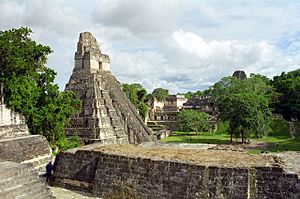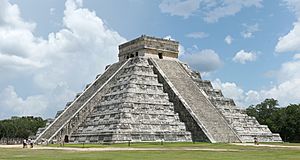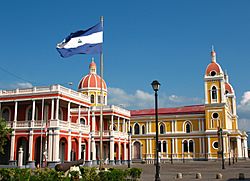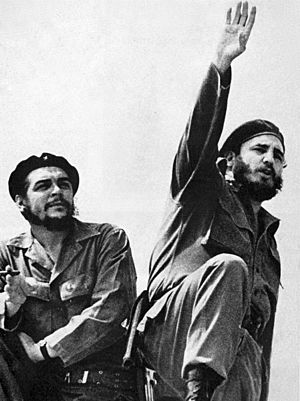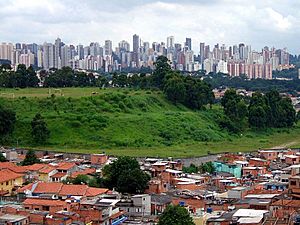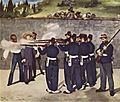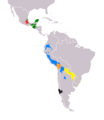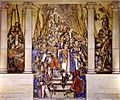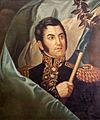Latin America facts for kids
 |
|
| Area | 20,111,457 km2 (7,765,077 sq mi) |
|---|---|
| Population | 642,216,682 (2018 est.) |
| Population density | 31/km2 (80/sq mi) |
| Ethnic groups |
|
| Demonym | Latin American |
| Countries | 20 |
| Dependencies | 14 |
| Languages | Romance languages Others: Quechua, Mayan languages, Haitian Creole, Antillean Creole, Guaraní, Caribbean Hindustani, Aymara, Nahuatl, English, German, Dutch, Mapudungun, Yiddish, Welsh, Russian, Ukrainian, Polish, Greek, Arabic, Chinese, Japanese, Korean, other languages |
| Time zones | UTC−02:00 to UTC−08:00 |
| Largest cities | Largest urban areas: 1. São Paulo 2. Mexico City 3. Buenos Aires 4. Rio de Janeiro 5. Bogotá 6. Lima 7. Santiago 8. Guadalajara 9. Monterrey 10. Belo Horizonte |
| UN M49 code | 419 – Latin America and the Caribbean019 – Americas001 – World |
Latin America is a big region in the Americas. It usually includes countries where people speak Spanish and Portuguese, like most of South America, Central America, and Mexico. Sometimes, islands in the Caribbean are also part of it. Some people also include countries where French is spoken.
The name "Latin America" comes from the fact that Spanish, Portuguese, and French languages all developed from Latin. These are called Romance languages. While many people in Latin America speak these languages, some also speak English (like in Guyana or Belize) or Dutch (like in Suriname). Many people also speak Native American languages. Paraguay is special because it has an official native language, Guaraní.
Most people in Latin America are Roman Catholic.
Contents
Countries and Regions
Latin America can be divided into different areas based on geography, politics, and culture. The main geographical parts are North America, Central America, the Caribbean, and South America. South America has smaller areas like the Southern Cone and the Andean states.
The term "Latin America" generally means the parts of the Americas south of the U.S.A. where a Romance language is mostly spoken. This includes countries where Spanish, Portuguese, or French are the main languages. For example, Puerto Rico is included, but places like Dominica or Saint Lucia are not, even if some French is spoken there, because it's not their official language.
*: Not a sovereign state
History of Latin America
Ancient Civilizations
People have lived in Latin America for a very long time. The oldest known settlement is in Chile, dating back about 14,000 years! Over thousands of years, people spread across the continents. By the year 1 AD, millions of people lived in South America's rainforests, mountains, and coasts.
Some groups built permanent settlements. The Chibchas in Colombia, and the Quechuas and Aymaras in Bolivia and Peru were three important groups.
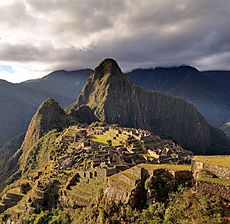
This region was home to many amazing indigenous peoples and advanced civilizations. These included the Aztecs, Toltecs, Maya, and Inca. The Maya had a "golden age" around 250 AD. The Aztecs and Incas became powerful later, in the 1300s and 1400s. The Aztec empire was one of the strongest in the Americas before the Spanish arrived.
European Arrival and Colonization
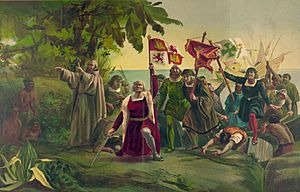
After Christopher Columbus's voyages, Europeans began to arrive. The powerful native leaders, like the Incas and Aztecs, lost their power. Hernán Cortés took control from the Aztecs with help from local groups who didn't like the Aztecs. Francisco Pizarro ended the Inca rule in Western South America.
Spain and Portugal were the main European countries to colonize the region. In 1494, they divided the world into areas they could control with the Treaty of Tordesillas. Spain got lands to the west, and Portugal got lands to the east (which became Brazil).
By the end of the 1500s, other countries like France also started taking over parts of North, Central, and South America. European culture, customs, and governments were brought in. The Roman Catholic Church became very powerful and was the only official religion.
Sadly, diseases like smallpox and measles brought by Europeans wiped out many native people. Historians aren't sure exactly how many died, but it was a huge number. Many survivors were forced to work on European farms and in mines. Over time, many people of mixed European and native ancestry (called mestizos) became a large part of the population.
Gaining Independence (1804–1825)
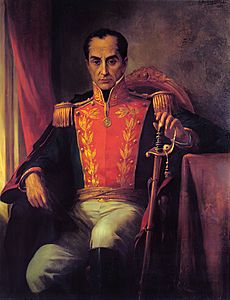
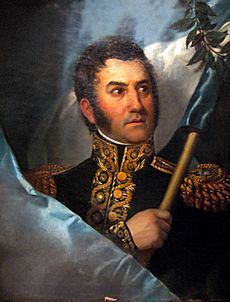
In 1804, Haiti was the first Latin American country to become independent. This happened after a big slave revolt led by Toussaint Louverture. They also ended slavery. Haiti's success inspired other independence movements in Spanish America.
By the late 1700s, Spain and Portugal were losing power. People in Latin America were unhappy with the rules set by the Spanish government. They also disliked that people born in Spain (called Peninsulares) held most of the important jobs. Napoleon's invasion of Spain in 1808 was a turning point. It made local leaders (called Criollos) want independence even more. Haiti's independence also encouraged leaders like Miguel Hidalgo in Mexico and Simón Bolívar in Venezuela.
Fights broke out between these local groups and the Spanish rulers. At first, some independence movements were stopped. But new leaders like Simón Bolívar and José de San Martín helped the movement grow stronger. By 1825, almost all of Spanish America was free from Spain, except for Puerto Rico and Cuba. Brazil became independent in 1822 and became an empire. In Mexico, a military officer named Agustín de Iturbide helped create a constitutional monarchy in 1822, but it soon became a republic in 1823.
World Wars (1914–1945)
Brazil's Role in World War II
After World War I, Brazil wanted to make its army stronger. In 1919, France helped Brazil improve its military. Brazil's President, Getúlio Vargas, wanted to make Brazil's industries grow. He traded with Germany, Italy, France, and the United States. Many German and Italian people had moved to Brazil, and some had important jobs. Vargas admired Adolf Hitler's Germany, but he knew he couldn't fully support the Nazis because of their racism against Brazil's large Black population.
Brazil tried to stay neutral between the U.S. and Germany. However, when German submarines attacked Brazilian trading ships, Brazil decided to join the Allies. On January 22, 1942, Brazil officially ended ties with Germany, Japan, and Italy.
Brazil sent about 25,000 soldiers, called the Brazilian Expeditionary Force, to fight in Italy. Brazil was the only Latin American country to send troops to Europe. After World War II, the U.S. and Latin America continued to have a close relationship.
The Cold War (1946–1990)
During the Cold War, the United States and the Soviet Union were in a global rivalry. The U.S. wanted to stop the spread of communism. Latin American countries often felt ignored by the U.S., which focused more on Europe and Asia. However, most Latin American countries sided with the U.S.
Cuban Revolution
In 1959, Fidel Castro led a revolution in Cuba and created the first communist country in the Americas. The U.S. put a trade ban on Cuba, which hurt Cuba's economy. Inspired by Cuba, some groups in other Latin American countries started fighting their governments. The U.S. helped these governments stop the rebellions.
In 1970, a Marxist leader, Salvador Allende, became president of Chile. But he was overthrown three years later by the military. Despite some conflicts, most Latin American countries eventually became democracies, except for Cuba.
Bay of Pigs Invasion
In 1961, the U.S. tried to overthrow Castro in Cuba with a secret invasion called the Bay of Pigs Invasion. It was a failure and very embarrassing for the U.S. government.
Cuban Missile Crisis
The Cuban Missile Crisis in October 1962 almost led to a war between the U.S. and the Soviet Union. The Soviets had placed missiles in Cuba that could reach the U.S. President John F. Kennedy ordered a naval blockade around Cuba. In the end, the Soviet leader, Nikita Khrushchev, agreed to remove the missiles. In return, the U.S. promised not to invade Cuba and to remove its own missiles from Turkey.
People and Cultures
Different Groups of People
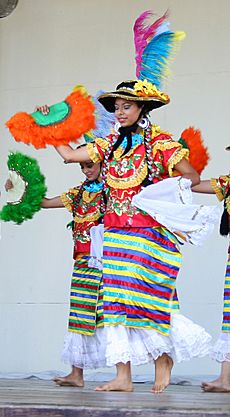
Latin America has many different groups of people, making it one of the most diverse places in the world.
- Native Peoples. These are the original people of the Americas. They make up the majority of the population in Bolivia, Peru, and Guatemala. In Mexico, a large part of the population is also Native American.
- Europeans. In the 1500s, many Spanish and Portuguese people came to Latin America. Today, most White Latin Americans are from Spanish and Portuguese backgrounds. They brought their languages, religions, and cultures. Brazil, Argentina, Mexico, and Colombia have the largest numbers of White people. White people are the majority in Uruguay, Argentina, Costa Rica, Puerto Rico, and Chile.
- Africans. Millions of African slaves were brought to the Americas starting in the 1500s. Most went to the Caribbean and Brazil. The Dominican Republic has a large Black population. Other countries with significant Black populations include Cuba, Puerto Rico, Colombia, and Venezuela.
- Asians. Several million people of Asian descent live in Latin America, mostly from Japan and China. The largest community of Japanese people outside of Japan is in Brazil. There are also growing Chinese populations in Panama and Costa Rica.
- Arabs or Middle Easterners. Many people of Arab descent live in Latin America, especially in the Hispanic-Caribbean regions. In the Dominican Republic, Arabs arrived in the 1800s and 1900s.
Biggest Cities
Urbanization (people moving to cities) grew quickly starting in the mid-1900s. Many people moved to capital cities or other important economic centers. For example, Monterrey in Mexico has grown a lot. Here are some of the largest cities in Latin America:
| City | Country | 2017 population | 2014 GDP (PPP, $million, USD) | 2014 GDP per capita, (USD) |
|---|---|---|---|---|
| Mexico City | 23,655,355 | $403,561 | $19,239 | |
| São Paulo | 23,467,354 | $430,510 | $20,650 | |
| Buenos Aires | 15,564,354 | $315,885 | $23,606 | |
| Rio de Janeiro | 14,440,345 | $176,630 | $14,176 | |
| Lima | 9,804,609 | $176,447 | $16,530 | |
| Bogotá | 7,337,449 | $209,150 | $19,497 | |
| Santiago | 7,164,400 | $171,436 | $23,290 | |
| Belo Horizonte | 6,145,800 | $95,686 | $17,635 | |
| Guadalajara | 4,687,700 | $80,656 | $17,206 | |
| Monterrey | 4,344,200 | $122,896 | $28,290 |
Languages Spoken
Spanish and Portuguese are the most common languages in Latin America. Portuguese is spoken mainly in Brazil. Spanish is the official language in most other countries, including Cuba, Puerto Rico (along with English), and the Dominican Republic.
Native American languages are widely spoken in Peru, Guatemala, Bolivia, Paraguay, and Mexico. They are less common in other countries.
Other European languages like English (in Puerto Rico) and French are also spoken. Some Creole languages, which mix different languages, are spoken, especially in the Caribbean. For example, Palenquero in Colombia mixes Spanish with African influences.
Economy and Tourism
Some experts believe that by 2050, Brazil and Mexico will be among the world's top five largest economies.
Tourism in Latin America
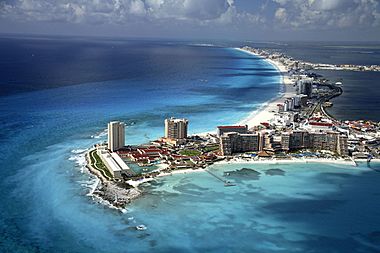
Money from tourism is very important for many Latin American countries. Mexico is one of the top 10 most visited countries in the world. In 2016, it had 35.1 million visitors! Other popular countries for tourists include Brazil, the Dominican Republic, Chile, Argentina, Cuba, Puerto Rico, Peru, and Colombia.
Some popular places to visit are Cancún, Riviera Maya, Galápagos Islands, Punta Cana, Chichen Itza, Cartagena, Cabo San Lucas, Mexico City, Machu Picchu, Rio de Janeiro, and Iguazú Falls.
Challenges: Poverty and Inequality
Poverty is still a big challenge for many countries in Latin America. It is also one of the regions with the most unequal distribution of wealth, meaning there's a big difference between the rich and the poor.
In 2011, some of the countries with the most poverty were Haiti, Dominican Republic, Nicaragua, Bolivia, and Honduras. For example, many people in Haiti and Nicaragua do not get enough food. A large percentage of people in these countries live below the poverty line.
Related pages
Images for kids
-
Presencia de América Latina (Presence of Latin America), a large mural in Chile.
-
Part of the ancient Inca road system in Argentina, now a UNESCO World Heritage Site.
-
The former Monument to Christopher Columbus in Buenos Aires.
-
Ferdinand VII of Spain, in whose name Spanish American leaders ruled during his exile.
-
Dom Pedro I, the first emperor of Brazil.
-
Argentine leader Juan Manuel de Rosas.
-
Mexican leader Antonio López de Santa Anna.
-
American soldiers occupying Mexico City during the Mexican-American War.
-
The Execution of Emperor Maximilian, a painting by Édouard Manet.
-
U.S. President Roosevelt and Mexican President Manuel Ávila Camacho in 1943.
-
Fidel Castro and his men in the Sierra Maestra mountains in 1956.
-
A poster of Che Guevara, a Cuban revolutionary.
-
Chilean leader Augusto Pinochet with U.S. Secretary of State Henry Kissinger.
-
Pope Paul VI and Salvadoran cleric Óscar Romero.
-
A ship passing through the Panama Canal.
-
Comandanta Ramona of the Zapatista Army of National Liberation in Mexico.
-
A meeting of UNASUR leaders in Santiago, Chile.
-
The beautiful Sanctuary of Las Lajas in southern Colombia.
-
An Amethyst mine in Brazil.
-
The new locks of the Panama Canal expansion project.
-
The General Rafael Urdaneta Bridge in Venezuela.
-
The Itaipu Dam in Brazil.
-
An aerial view of Cancún, a popular tourist destination.
-
A Roman Catholic Easter procession in Comayagua, Honduras.
-
Diego Rivera's mural about Mexico's history at the National Palace.
-
Mexican film director Alejandro González Iñárritu.
-
President Cristina Fernández de Kirchner with the cast and Oscar award for The Secret in Their Eyes.
-
Juana Inés de la Cruz, a famous writer from the 17th century.
-
Argentine writer Jorge Luis Borges.
-
Chilean poet Gabriela Mistral, who won a Nobel Prize.
-
Gabriel García Márquez signing his book One Hundred Years of Solitude.
-
Brazilian singer Carmen Miranda.
-
A couple dancing tango.
-
Sumidero Canyon in Mexico.
-
A Glaucous macaw and other colorful parrots.
-
Simón Bolívar, a key figure in Latin American independence.
-
José de San Martín, another important independence leader.
-
Bernardo O'Higgins, a hero of Chilean independence.
-
Father Miguel Hidalgo, a leader of Mexican independence.
-
Vicente Guerrero, a hero of Mexican independence.
-
Agustín de Iturbide, who became emperor of Mexico.
See also
 In Spanish: América Latina para niños
In Spanish: América Latina para niños


